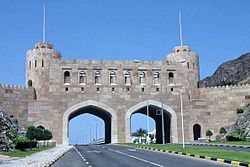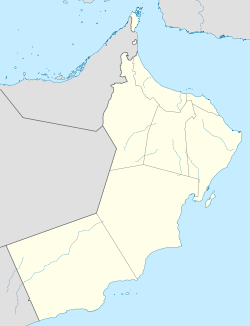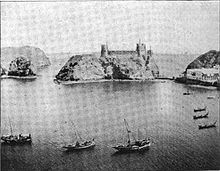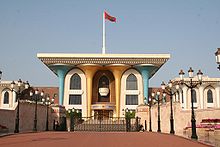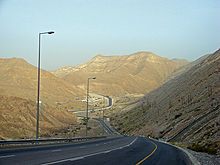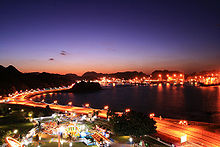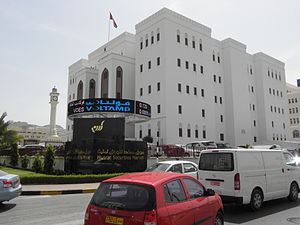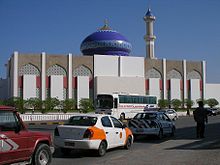- Muscat, Oman
-
For other uses, see Muscat (disambiguation).
Muscat
Masqat (Arabic)— City — Muscat Gate 
Flag
Coat of armsLocation of Muscat in Oman Coordinates: 23°36′31″N 58°35′31″E / 23.60861°N 58.59194°E Country  Oman
OmanGovernorate Muscat Government - Type Absolute monarchy - Sultan Qaboos bin Said Area - Metro 3,500 km2 (1,351.4 sq mi) Population (2008) - Metro 1,090,797 Time zone Oman standard time (UTC+4) Website http://www.mm.gov.om/english Muscat (Arabic: مسقط, Masqaṭ) is the capital of Oman. It is also the seat of government and largest city in the Governorate of Muscat. As of 2008, the population of the Muscat metropolitan area was 1,090,797.[1] The metropolitan area spans approximately 1,500 km2 (580 sq mi) and includes six provinces called wilayats. Known since the early 1st century CE as an important trading port between the west and the east, Muscat was ruled by various indigenous tribes as well as foreign powers such as the Persians and the Portuguese Empire at various points in its history. A regional military power in the 18th century, Muscat's influence extended as far as East Africa and Zanzibar. As an important port-town in the Gulf of Oman, Muscat attracted foreign tradesmen and settlers such as the Persians, the Balochs and Gujaratis. Since the ascension of Qaboos bin Said as Sultan of Oman in 1970, Muscat has experienced rapid infrastructural development that has led to the growth of a vibrant economy and a multi-ethnic society.
The rocky Western Al Hajar Mountains dominate the landscape of Muscat. The city lies on the Arabian Sea along the Gulf of Oman and is in the proximity of the strategic Straits of Hormuz. Low-lying white buildings typify most of Muscat's urban landscape, while the port-district of Muttrah, with its corniche and harbour, form the north-eastern periphery of the city. Muscat's economy is dominated by trade, petroleum and porting.
Contents
Etymology
Ptolemy's Map of Arabia identifies the territories of Cryptus Portus[2] and Moscha Portus.[3] Scholars are divided in opinion on which of the two related to the city of Muscat. Similarly, Arrianus references Omana and Moscha in Voyage of Nearchus. Interpretations of Arrianus' work by William Vincent and Jean Baptiste Bourguignon d'Anville conclude that Omana was a reference to Oman, while Moscha referred to Muscat.[4] Similarly, other scholars identify Pliny the Elder's reference to Amithoscuta to be Muscat.[2]
The origin of the word Muscat is disputed. Some authors claim that the word has Arabic origins – from moscha, meaning an inflated hide or skin.[5] Other authors claim that the name Muscat means anchorage or the place of "letting fall the anchor".[6] Other derivations include muscat from Old Persian, meaning strong-scented,[7] or Arabic meaning falling-place,[8] or meaning hidden.[9] Maas-gat in the old Persian means "fishing place" (Moscha Portus). Even Masandam means "massan (fishes)+ dam (net)" in the old Persian. Cryptus Portus is synonymous with Oman ("hidden land"). But "Ov-man" (Omman) and the old sumerian name Magan (Maa-kan) means sea-people in Persian and Arabic.
History
Evidence of communal activity in the area around Muscat dates back to the 6th millennium BCE in Ras al-Hamra, where burial sites of fishermen have been found. The graves appear to be well formed and indicate the existence of burial rituals. South of Muscat, remnants of Harappan pottery indicate some level of contact with the Indus Valley Civilisation.[10] Muscat's notability as a port was acknowledged as early as the 1st century CE by Greek geographers Ptolemy, who referred to it as Cryptus Portus (the Hidden Port), and by Pliny the Elder, who called it Amithoscuta.[11]
The port fell to a Sassanid invasion in the 3rd century CE, under the rule of Shapur I.,[12] while conversion to Islam occurred during the 7th century. Muscat's importance as a trading port continued to grow in the centuries that followed, under the influence of the Azd dynasty, a local tribe. The establishment of the First Imamate in the 9th century CE was the first step in consolidating disparate Omani tribal factions under the banner of an Ibadi state. However, tribal skirmishes continued, allowing the Abbasids of Baghdad to conquer Oman. The Abbasids occupied the region until the 11th century, when they were driven out by the local Yahmad tribe. Power over Oman shifted from the Yahmad tribe to the Azdi Nabahinah clan, during whose rule, the people of coastal ports such as Muscat prospered from maritime trade and close alliances with the Indian subcontinent, at the cost of the alienation of the people of the interior of Oman.
The Portuguese conqueror Afonso de Albuquerque attacked Muscat in July, 1507. A bloody battle ensued between the Portuguese and forces loyal to the Persian governor of the city. After the fall of the town, Albuquerque massacred most of the remaining inhabitants – men, women and children, following which the town was occupied and pillaged.[13]
The Portuguese maintained a hold on Muscat for over a century, despite challenges from Persia and a bombardment of the town by the Turks in 1546.[14] The Turks twice captured Muscat from the Portuguese, in the Capture of Muscat (1552) and 1581-88. The election of Nasir bin Murshid al-Yaribi as Imam of Oman in 1624 changed the balance of power again in the region, from the Persians and the Portuguese to local Omanis. On August 16, 1648 the Imam dispatched an army to Muscat, which captured and demolished the high towers of the Portuguese, weakening their grip over the town. Decisively, in 1650, a small but determined body of the Imam's troops attacked the port at night, forcing an eventual Portuguese surrender on January 23, 1650.[15] A civilian war, and repeated incursions by the Persian king Nadir Shah in the 18th century destabilised the region, and further strained relations between the interior and Muscat. This power vacuum in Oman led to the emergence of the Al Bu Sa‘id dynasty, which has ruled Oman ever since.[16]
"Muscat is a large and very populous town, flanked on both sides with high mountains and the front is close to the water's edge; behind, towards the interior, there is a plain as large as the square of Lisbon, all covered with salt pans. [T]here are orchards, gardens, and palm groves with wells for watering them by means of swipes and other engines. The harbour is small, shaped like a horse-shoe and sheltered from every wind." —Afonso de Albuquerque, after the fall of Muscat, in 1507.[13] Muscat's naval and military supremacy was re-established in the 19th century by Said bin Sultan, who gained control over Zanzibar, eventually moving his capital to Stone Town, the ancient quarter of Zanzibar City, in 1840. However, after his death in 1856, control over Zanzibar was lost when it became an independent sultanate under his sixth son, Majid bin Said (1834/5–1870), while the third son, Thuwaini bin Said, became the Sultan of Oman. During the second half of the 19th century, the fortunes of the Al Bu Sa`id declined and friction with the Imams of the interior resurfaced. Muscat and Muttrah were attacked by tribes from the interior in 1895 and again in 1915.[17] A tentative ceasefire was brokered by the British, which gave the interior more autonomy. However, conflicts among the disparate tribes of the interior, and with the Sultan of Muscat and Oman continued into the 1950s, and eventually escalated into the Dhofar Rebellion (1962). The rebellion forced the Sultan Said bin Taimur to seek the assistance of the British in quelling the uprisings from the interior. The April 26, 1966 failed assassination attempt on Said bin Taimur led to the further isolation of the Sultan, who had moved his residence from Muscat to Salalah, amidst the civilian armed conflict. On July 23, 1970, Qaboos bin Said, son of the Sultan, staged a bloodless[18]coup d'état in the Salalah palace with the assistance of the British, and took over as ruler.
With the assistance of the British, Qaboos bin Said put an end to the Dhofar uprising and consolidated disparate tribal territories. He renamed the country the Sultanate of Oman (called Muscat and Oman hitherto), in an attempt to end to the interior's isolation from Muscat. Qaboos enlisted the services of capable Omanis to fill positions in his new government,[19] drawing from such corporations as Petroleum Development Oman (PDO). New ministries for social services such as health and education were established. The construction of Mina Qaboos, a new port conceived initially by Sa`id bin Taimur, was developed during the early days of Qaboos' rule. Similarly, a new international airport was developed in Muscat's Seeb district. A complex of offices, warehouses, shops and homes transformed the old village of Ruwi in Muttrah into a commercial district.[20] The first five-year development plan in 1976 emphasised infrastructural development of Muscat, which provided new opportunities for trade and tourism in the 1980s – 1990s, attracting migrants from around the region. On June 6, 2007, Cyclone Gonu hit Muscat causing extensive damage to property, infrastructure and commercial activity.
Geography
Muscat is located in northeast Oman, at 24°00′N 57°00′E / 24°N 57°E. The Tropic of Cancer passes south of the area. It is bordered to its west by the plains of the Al Batinah Region and to its east by Ash Sharqiyah Region. The interior plains of the Ad Dakhiliyah Region border Muscat to the south, while the Gulf of Oman forms the northern and western periphery of the city. The water along to coast of Muscat runs deep, forming two natural harbours, in Muttrah and Muscat. The Western Al Hajar Mountains run through the northern coastline of the city.
Volcanic rocks are apparent in the Muscat area, and are composed of serpentine and diorite, extending along the Gulf of Oman coast for ten or twelve 16 kilometres (9.9 mi) from the district of Darsait to Yiti.[21] Plutonic rocks constitute the hills and mountains of Muscat and span approximately 30 miles (48 km) from Darsait to Ras Jissah. These igneous rocks consists of serpentine, greenstone and basalt, typical of rocks in Southeastern regions of the Arabian Peninsula. South of Muscat, the volcanic rock strata is broken up and distorted, rising to a maximum height of 6,000 feet (1,800 m), in Al Dakhiliyah, a region which includes Jebel Akhdar, the country's highest range. The hills in Muscat are mostly devoid of vegetation but are rich in iron.
The halophytic sabkha type desert vegetation is predominant in Muscat.[22] The Qurum Nature Reserve contains plants such as the Arthrocnemum Macrostachyum and Halopeplis Perfoliata Coral reefs are common in Muscat. Acropora reefs exist in the sheltered bays of the satellite towns of Jussah and Khairan.[23] Additionally, smaller Porites reef colonies exist in Khairan, which have fused to form a flat-top pavement is visible at low tide. Crabs and spiny crayfish are found in the waters of the Muscat area, as are sardines and bonito.[24] Glassfish are common in freshwater estuaries, such as the Qurum Nature Reserve.[25]
The Al Sultan Qaboos Street forms the main artery of Muscat, running west-to-east through the city. The street eventually becomes Al Nahdah Street near Al Wattayah. Several inter-city roads such as Nizwa Road and Al Amrat Road intersect with Al Sultan Qaboos Road (in Rusail and Ruwi, respectively). Muttrah, with the Muscat Harbour, Corniche, and Mina Qaboos is located in the north-eastern coastline of the city, adjacent to the Gulf of Oman. Other coastal districts of Muscat include Darsait, Mina Al Fahal, Ras Al Hamar, Al Qurum Heights, Al Khuwair and Al Seeb. Residential and commercial districts further inland include Al Hamriyah, Al Wadi Al Kabir, Ruwi, Al Wattayah, Madinat Qaboos, Al Azaiba and Al Ghubra.
Climate
Main article: Climate of MuscatMuscat features a hot, arid climate with long and very hot summers and warm "winters". Annual rainfall in Muscat is about 10 cm (4 in), falling mostly in March. In general precipitation is scarce in Muscat, with several months on average seeing only a trace of rainfall. The climate generally is very hot, with temperatures reaching as high as 40°C (104°F) in the summer.
Climate data for Muscat Month Jan Feb Mar Apr May Jun Jul Aug Sep Oct Nov Dec Year Average high °C (°F) 25
(77)26
(79)29
(84)34
(93)39
(102)40
(104)38
(100)36
(97)35
(95)34
(93)30
(86)27
(81)32.8
(91.0)Average low °C (°F) 17
(63)18
(64)20
(68)24
(75)29
(84)30
(86)30
(86)28
(82)27
(81)24
(75)21
(70)18
(64)23.8
(74.9)Precipitation mm (inches) 10.7
(0.421)11.7
(0.461)38.4
(1.512)14.6
(0.575)0.1
(0.004)0
(0)3.5
(0.138)1.8
(0.071)0
(0)0.4
(0.016)1.7
(0.067)11.4
(0.449)94.3
(3.713)Source: Foreca[26] Economy
The Muscat Securities Market in Central Business District
Muscat's economy, like that of Oman, is dominated by trade. The more traditional exports of the city included dates, mother of pearl, and fish. Many of the souks of Muttrah sell these items and traditional Omani artefacts. Petroleum Development Oman (PDO) has been central to Muscat's economy since at least 1962 and is the country's second largest employer, after the government. PDO's major shareholders include Royal Dutch/Shell, Total, and Partex and its production is estimated to be about 720,000 barrels per day (114,000 m3/d). Muscat also has major trading companies such as Suhail Bahwan Group, which is a trading partner for corporations such as Toshiba, Subaru, Seiko, Hewlett Packard, General Motors, RAK Ceramics; Saud Bahwan Group whose trading partners are Toyota, Daihatsu and Hertz Rent-a-Car; and Zubair Automotive whose trading partners include Mitsubishi, and Chrysler brands such as Dodge. The private Health Care sector of Muscat,Oman has numerous hospitals and clinics.
The Muscat Securities Market is the principal stock exchange of Oman. It is located in Central Business District of Muscat and it was established in 1988, and has since distinguished itself as a pioneer among its regional peers in terms of transparency and disclosure regulations and requirements.
Mina Sultan Qaboos, Muscat's main trading port, is a trading hub between the Persian Gulf, the Indian subcontinent and the Far East with an annual volume of about 1.6 million tons. However, the emergence of the Jebel Ali Free Zone in neighboring Dubai, United Arab Emirates, has made that port the premier maritime trading port of the region with about 44 million tons traded in cargo annually. Many infrastructural facilities are owned and operated by the government of Oman. Omantel is the major telecommunications organization in Oman and provides local, long-distance and international dialing facilities and operates as the country's only ISP. Recent liberalization of the mobile telephone market has seen the establishment of a second provider — Nawras.[citation needed]
The airline Oman Air has its head office on the grounds of Muscat International Airport.[27]
Demographics
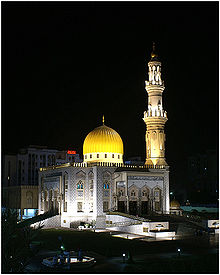 The Zawawi Mosque in Al Khuwair, Muscat. A majority of Omanis are Ibadhi Muslims.
The Zawawi Mosque in Al Khuwair, Muscat. A majority of Omanis are Ibadhi Muslims.
According to the 2003 census conducted by the Oman Ministry of National Economy, the population of Muscat is over 630,000, which included 370,000 males and 260,000 females.[28] Muscat formed the second largest governorate in the country, after Al Batinah, accounting for 27% of the total population of Oman. As of 2003, Omanis constituted 60% of the total population of Muscat, while expatriates accounted for about 40%.[29] The population density of the city was 162.1
The governorate of Muscat comprises six wilayats – Muttrah, Bawshar, Seeb, Al Amrat, Muscat and Qurayyat. Of the wilayats, Seeb, located in the western section of the governorate, was the most populous (with over 220,000 residents), while Muttrah had the highest number of expatriates (with over 100,000).[28] Approximately 71% of the population was within the 15-64 age group, with the average Omani age being 23 years.[30] About 10% of the population is illiterate, an improvement when compared to the 18% illiteracy rate recorded during to 1993 census. Expatriates accounted for over 60% of the labour force dominated by males, who accounted for 80% of the city's total labour. A majority of expatriates (34%) engineering-related occupations, while most Omanis worked in engineering, clerical, scientific or technical fields. The defense sector was the largest employer for Omanis, while construction, wholesale and retail trade employed the largest number of expatriates.
The ethnic makeup of Muscat has historically been influenced by people not native to the Arabian Peninsula. British Parliamentary papers dating back to the 19th century indicate the presence of a significant Hindu Gujarati merchants in the city[31] Indeed, four Hindu temples existed in Muscat ca. 1760 [32] Christianity is thought to have been brought in by the Portuguese in 1507.[33] Protestant missionaries established a hospital in Muscat in the 19th century.
Like the rest of Oman, Arabic is the predominant language of the city. In addition, English, Balochi, Swahili and South Asian languages such as Hindi, Gujarati, Malayalam and Urdu [34] are spoken by the residents of Muscat. Islam is the predominant religion in the city, with most followers being Ibadi Muslims. Non-Muslims are allowed to practice their religion, but may not proselytize publicly or distribute religious literature.
Notable landmarks
 The Royal Opera House Muscat in Shati Al-Qurm district of Muscat
The Royal Opera House Muscat in Shati Al-Qurm district of Muscat
The city has numerous mosques including the Sultan Qaboos Grand Mosque, Ruwi Mosque and Zawawi Mosque. A few Shi'ite mosques also exist here.The city has two Hindu temples – a Shiva temple and a Krishna temple. Christians, too have built their churches here on a multi-denominational compound in Ruwi.
Muscat has a number of museums. These include Museum of Omani Heritage, National Museum of Oman, Oman Children's Museum, Oman Natural History Museum, Bait al Zubair, Oman Oil and Gas Exhibition Centre, Omani French Museum, Sultan's Armed Forces Museum and the Omani Aquarium and Marine Science and Fisheries Centre.[35] The Bait Al Falaj Fort played an important role in Muscat's military history.
Several new projects are being planned including a opera house - which which will open its doors on October 14, 2011, Muscat Grand Mall-the biggest mall in Oman-which is set to open at the end of the year and several new hotels (some of these projects have already been launched). One of the most notable projects is the Oman National Museum. It is expected to be an architectural jewel along with the Sultan Qaboos Grand Mosque.
Visitors are also encouraged to visit Old Muscat and the Old Palace. The main shopping district is situated in Al Qurum Commercial Area, however shopping malls are spread out throughout the city.
Transport
An orange and white taxi in front of a mosque in Ruwi.
The main airport is Muscat International Airport around 25 km (16 mi) from the city's business district of Ruwi and 15 to 20 km from the main residential localities of Al-Khuwair, Madinat Al Sultan Qaboos, Shati Al-Qurm and Al-Qurm. Muscat is the headquarters for the local Oman Air, which flies to several destinations within the Middle East, the Indian Subcontinent, East Africa and Europe. Other airlines such as Turkish Airlines, Sri Lankan, Royal Jordanian, British Airways, PIA, Jet Airways, Lufthansa, Emirates, Swiss International Air Lines, Kuwait Airways, Air India and Thai Airways also fly through Muscat International Airport.
The Muscat area is well serviced by paved roads and dual-carriageway connects most major cities and towns in the country. Public transportation in Muscat does not include rail, and bus services are limited in their route coverage. There is no rail or metro network in the country. Several forms of public transport are popular in Oman. Most popular are the "Baiza" buses, so named for the lower denomination of the Omani Rial, the baiza (an adaptation of the Indian lower denomination paisa). These are relatively inexpensive and service all major roadways, as well as a wide and loose network of smaller byways in the greater Muscat metropolitan area, opportunistically dropping off and picking up passengers at any location. Less popular and slightly more expensive are large public buses, coloured red and green, whose service is limited to major roadways and point-to-point travel routes between Oman's major cities and towns. Taxis, also colour-coded orange and white, provide semi-personal transportation in the form of both individual hire and the same opportunistic roadway service as Baiza buses.
Baiza buses and colour-coded orange-and-white taxis are unmetered, after several government initiatives to introduce meters were rejected. The fare is set by way of negotiation, although taxi drivers usually adhere to certain unwritten rules for fares within the city. In many countries, one is advised to negotiate a fare with the driver before getting into a taxi. However, in Oman, asking for the fare beforehand often demonstrates a passenger's newness and unfamiliarity with the area. One should always find out the normally accepted fare for one's journey from one's hotel or host before looking for a taxi. Taxis will also generally take passengers to locations out of the city, including Sohar, Buraimi and Dubai.
Gallery
-
The Mutrah Corniche was renovated to undo the destruction done by Cyclone Gonu
References
- ^ World Gazetteer
- ^ a b Foster (1844), p.231.
- ^ Foster (1844), p.241.
- ^ Foster (1844), p.173.
- ^ Foster (1844), p.173
- ^ Miles (1997), p.468.
- ^ Hailman (2006), p.49.
- ^ Philips (1966), p.4.
- ^ Room (2003), p.246.
- ^ Rice (1994), p.255-256
- ^ Foster (1844), p.234.
- ^ Potter (2002), p.41.
- ^ a b Miles (1997), p.147.
- ^ Miles (1997), p.167
- ^ Miles (1997), p. 196.
- ^ Miles (1997), p.256.
- ^ JE Peterson's Britannica entry (1990), p.6.
- ^ Long (2007), p.188.
- ^ Middle East Policy (2004), p.126.
- ^ Middle East Policy (2004), p.128
- ^ Miles (1997), p.399.
- ^ Ghazanfar (1998), p.80.
- ^ Salm (1993), p.52
- ^ Miles (1997), p.410.
- ^ Barth (2002), p.292.
- ^ MSN Weather
- ^ http://www.omanair.com/wy/about-us/global-offices Contact Us]." Direct image link. Oman Air. Retrieved on 3 December 2010.
- ^ a b Oman Census (2003), p.6.
- ^ Oman Census (2003), p.9.
- ^ Oman Census(2003), Data and Other Indicators
- ^ British Parliamentary Papers (1876), p.189.
- ^ Kechichian (1995), p.215.
- ^ Fahlbusch (1999), p.829.
- ^ Peterson (2004), p.34.
- ^ "Museums". Omanet.om. http://www.omanet.om/english/tourism/entert/museums.asp?cat=tour&subcat=entert1. Retrieved January 18, 2009.
Further reading
- Foster, Charles (1844). The Historical Geography of Arabia. Duncun and Malcolm. http://www.google.com/books?id=Lb42AAAAMAAJ.
- Miles, Samuel Barrett; Robin Bidwell (1997). The Countries and Tribes of the Persian Gulf. Garnet & Ithaca Press. ISBN 9781873938560. http://www.google.com/books?id=dbsOoPpZiSEC.
- Ghazanfar, Shahina A.; Martin Fisher (1998). Vegetation of the Arabian Peninsula. Springer. ISBN 9780792350156. http://books.google.com/?id=OPniyjxTu-UC&printsec=frontcover.
- Salm, Rodney V.; Rolf A.C. Jensen, Vassili Papastavrou (1993). Marine Fauna of Oman. IUCN. ISBN 9782831701806. http://books.google.com/?id=OPniyjxTu-UC&printsec=frontcover.
- "World Gazetteer: Masqat - profile of geographical entity including name variants". http://world-gazetteer.com/wg.php?x=&men=gpro&lng=en&des=wg&geo=-2851&srt=npan&col=abcdefghinoq&msz=1500&pt=c&va=&geo=-1049459. Retrieved 2008-09-17.
- Hailman, John (2006). Thomas Jefferson on Wine. University Press of Mississippi. ISBN 9781578068418. http://www.google.com/books?id=dbsOoPpZiSEC.
- Phillips, Wendell (1966). Unknown Oman. D. McKay Co.. pp. 4.
- Room, Adrian (2003). Placenames of the World: Origins and Meanings of the Names for Over 5000 Natural Features, Countries, Capitals, Territories, Cities and Historic Sites. McFarland. ISBN 9780786418145. http://books.google.com/?id=PzIer-wYbnQC&pg=PA246.
- Barth, Hans-Jörg; Benno Böer (2002). Sabkha Ecosystems: The Arabian Peninsula and Adjacent Countries. Springer. ISBN 9781402005046. http://books.google.com/?id=O7fIy_Rwgc8C&pg=PA99.
- Census Administration. "Final Results of the Census 2003" (PDF). Ministry of the National Economy, Government of Oman. http://www.omancensus.net/english/pdf_files/final_results.pdf. Retrieved 2008-09-17.[dead link]
- Census Administration. "Data & Indicators of the Population". Ministry of the National Economy, Government of Oman. Archived from the original on 2008-06-13. http://web.archive.org/web/20080613154426/http://www.omancensus.net/english/selected_data_population_muscat.asp. Retrieved 2008-09-17.
- Parliamentary Papers. London: United Kingdom Parliament. 1876. http://books.google.com/?id=-UMTAAAAYAAJ&pg=PA181.
- Kechichian, Joseph A. (1995). Oman and the World: The Emergence of an Independent Foreign Policy. Great Britain: RAND Corporation. ISBN 9780833023322. http://books.google.com/?id=SIns4vhNgRkC&printsec=frontcover.
- Fahlbusch, Erwin; Geoffrey William Bromiley, David B. Barrett (1999). The Encyclopedia of Christianity. Wm. B. Eerdmans Publishing. ISBN 9780802824158. http://books.google.com/?id=7ly4DgtT3LkC&pg=PA829.
- Rice, Michael (1994). The Archeology of the Arabian Gulf. Routledge. ISBN 9780415032681. http://books.google.com/?id=kWRfe7AdVaYC.
- Potter, Lawrence; Sick, Gary (2002). Security in the Persian Gulf. Macmillan. ISBN 9780312239503. http://www.google.com/books?id=nYphS6AV8OwC.
- Long, David E.; Reich, Bernard; Gasiorowski, Mark (2007). The Government and Politics of the Middle East and North Africa. Westview Press. ISBN 9780813343617. http://books.google.com/?id=LpGGbueEuXsC.
External links
Coordinates: 23°37′N 58°32′E / 23.61°N 58.54°E
Capitals of Arab countries Africa Asia - Cairo 1996 (Egypt)
- Tunis 1997 (Tunisia)
- Sharjah 1998 (United Arab Emirates)
- Beirut 1999 (Lebanon)
- Riyadh 2000 (Saudi Arabia)
- Kuwait 2001 (Kuwait)
- Amman 2002 (Jordan)
- Rabat 2003 (Morocco)
- San'a 2004 (Yemen)
- Khartoum 2005 (Sudan)
- Muscat 2006 (Oman)
- Algiers 2007 (Algeria)
- Damascus 2008 (Syria)
- Jerusalem 2009 (Jerusalem)
- Doha 2010 (Qatar)
- Sirte 2011 (Libya)
- Manama 2012 (Bahrain)
- Baghdad 2013 (Iraq)
Portuguese Empire North Africa15th century
1415–1640 Ceuta
1458–1550 Alcácer Ceguer (El Qsar es Seghir)
1471–1550 Arzila (Asilah)
1471–1662 Tangier
1485–1550 Mazagan (El Jadida)
1487– middle 16th century Ouadane
1488–1541 Safim (Safi)
1489 Graciosa16th century
1505–1769 Santa Cruz do Cabo
de Gué (Agadir)
1506–1525 Mogador (Essaouira)
1506–1525 Aguz (Souira Guedima)
1506–1769 Mazagan (El Jadida)
1513–1541 Azamor (Azemmour)
1515 São João da Mamora (Mehdya)
1577–1589 Arzila (Asilah)Sub-Saharan Africa15th century
1455–1633 Arguin
1470–1975 Portuguese São Tomé1
1474–1778 Annobón
1478–1778 Fernando Poo (Bioko)
1482–1637 Elmina (São Jorge
da Mina)
1482–1642 Portuguese Gold Coast
1496–1550 Madagascar (part)
1498–1540 Mascarene Islands16th century
1500–1630 Malindi
1500–1975 Portuguese Príncipe1
1501–1975 Portuguese E. Africa
(Mozambique)
1502–1659 St. Helena
1503–1698 Zanzibar
1505–1512 Quíloa (Kilwa)
1506–1511 Socotra
1557–1578 Portuguese Accra
1575–1975 Portuguese W. Africa
(Angola)
1588–1974 Cacheu2
1593–1698 Mombassa (Mombasa)17th century
1642–1975 Portuguese Cape Verde
1645–1888 Ziguinchor
1680–1961 São João Baptista de Ajudá
1687–1974 Portuguese Bissau2
18th century
1728–1729 Mombassa (Mombasa)
1753–1975 Portuguese São Tomé and Príncipe
19th century
1879–1974 Portuguese Guinea
1885–1975 Portuguese Congo1 Part of São Tomé and Príncipe from 1753. 2 Part of Portuguese Guinea from 1879. Southwest Asia16th century
1506–1615 Gamru (Bandar-Abbas)
1507–1643 Sohar
1515–1622 Hormuz (Ormus)
1515–1648 Quriyat
1515–? Qalhat
1515–1650 Muscat
1515?–? Barka
1515–1633? Julfar (Ras al-Khaimah)
1521–1602 Bahrain (Muharraq and Manama)
1521–1529? Qatif
1521?–1551? Tarut Island
1550–1551 Qatif
1588–1648 Matrah17th century
1620–? Khor Fakkan
1621?–? As Sib
1621–1622 Qeshm
1623–? Khasab
1623–? Libedia
1624–? Kalba
1624–? Madha
1624–1648 Dibba Al-Hisn
1624?–? Bandar-e KongIndian subcontinent15th century
1498–1545 Laccadive Islands
(Lakshadweep)16th century
Portuguese India
· 1500–1663 Cochim (Kochi)
· 1502–1661 Quilon (Coulão/Kollam)
· 1502–1663 Cannanore (Kannur)
· 1507–1657 Negapatam (Nagapatnam)
· 1510–1962 Goa
· 1512–1525 Calicut (Kozhikode)
· 1518–1619 Chaul
· 1523–1662 Mylapore
· 1528–1666 Chittagong
· 1531–1571 Chalium
· 1534–1601 Salsette Island
· 1534–1661 Bombay (Mumbai)
· 1535–1739 Baçaím (Vasai-Virar)
· 1536–1662 Cranganore (Kodungallur)
· 1540–1612 Surat
· 1548–1658 Tuticorin (Thoothukudi)16th century (continued)
Portuguese India (continued)
· 1559–1962 Daman and Diu
· 1568–1659 Mangalore
· 1579–1632 Hugli
· 1598–1610 Masulipatnam (Machilipatnam)
1518–1521 Maldives
1518–1658 Portuguese Ceylon (Sri Lanka)
1558–1573 Maldives
17th century
Portuguese India
· 1687–1749 Mylapore
18th century
Portuguese India
· 1779–1954 Dadra and Nagar HaveliEast Asia and Oceania16th century
1511–1641 Portuguese Malacca
1512–1621 Ternate
· 1576–1605 Ambon
· 1578–1650 Tidore
1512–1665 Makassar
1553–1999 Portuguese Macau
1571–1639 Decima (Dejima, Nagasaki)17th century
1642–1975 Portuguese Timor (East Timor)1
19th century
Portuguese Macau
· 1864–1999 Coloane
· 1849–1999 Portas do Cerco
· 1851–1999 Taipa
· 1890–1999 Ilha Verde
20th century
Portuguese Macau
· 1938–1941 Lapa and Montanha (Hengqin)1 1975 is the year of East Timor's Declaration of Independence and subsequent invasion by Indonesia. In 2002, East Timor's independence was recognized by Portugal & the world.
North America and the North Atlantic Ocean16th century
1500–1579? Terra Nova (Newfoundland)
1500–1579? Labrador
1516–1579? Nova ScotiaCentral and South America16th century
1500–1822 Brazil
1536–1620 Portuguese Barbados17th century
1680–1777 Nova Colônia do Sacramento
19th century
1808–1822 Cisplatina (Uruguay)Capital: MuscatAbu Nukhayl · Ad Duwaykah · Al Amarat · Al Bustan · Al Jafnayn · Al Khawd · Ash Shutayfi · Bandar Jissah · Bandar Khayran · Bawshar · Bayt al Falaj · Bin `Umran · Falaj · Falaj ash Sham · Fath al Bu Sa`id · Ghallah · Ghubrah · Ghursheba · Halban · Hamriyah · Haramil · Hayl al `Umayr · Jal · Jifar · Kalbuh · Lansab · Ma`abilah · Manumah · Muscat · Matrah · Mawalih · Mu`skar al Murtafi`ah · Qantab · Riyam · Rusayl · Ruwi · Sad · Saruq · Sayh al Malih · Seeb · Sidab · Suraj · Tawiyan · Tawiyan Yiti · Taww · Wadi Kabir · Wutayyah · Yenkit ·
YitiCategories:- Arab Capital of Culture
- Populated places in the Muscat Governorate
- Muscat
- Capitals in Asia
- Populated coastal places in Oman
- Populated places established in the 2nd century
- Former Portuguese colonies
- Port cities in the Arabian Peninsula
- Gulf of Oman
Wikimedia Foundation. 2010.

